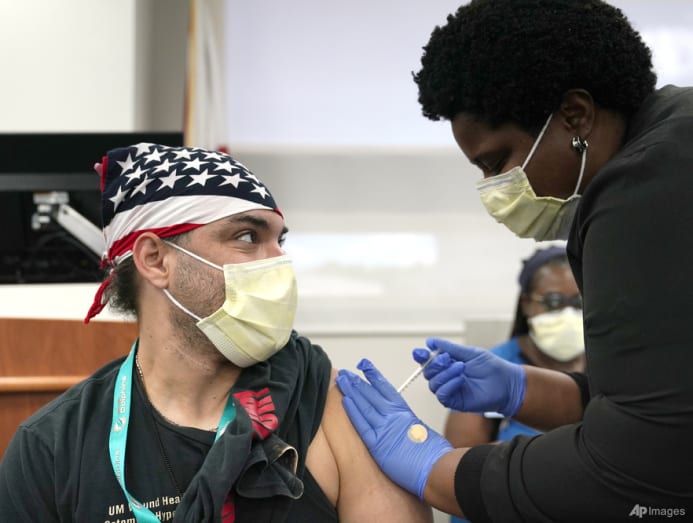Commentary: After year and a half in the ‘war zone’, US nurses are quitting en masse
Growing workloads and inadequate staffing are fuelling nurse burnout in the US, as well as hospitals’ desperation to fill staff vacancies, says a nursing professor.

TAMPA, Florida: The fourth wave of COVID-19 is exacerbating the ongoing crisis for the nursing workforce and has led to burnout for many nurses.
As a result, many are quitting their jobs in substantial numbers all across the United States, with 62 per cent of hospitals reporting a nurse vacancy rate higher than 7.5 per cent, according to a 2021 NSI Nursing Solutions report.
But the global pandemic has only worsened problems that have long existed within the nursing profession – in particular, widespread stress and burnout, health and safety issues, depression and work-related post-traumatic stress disorder, and even increased risk of suicide.
In addition, nurses need to contend with growing workloads and inadequate staffing, or not having the right number of nurses on the right units to ensure that patients receive safe quality care.
Mandatory overtime is another challenge and occurs when nurses must work extra hours beyond their shift because of staffing shortages.
All of these issues can lead to low job satisfaction among nurses and are likely to contribute to nurses’ leaving the profession, a trend that began well before the current pandemic struck.
Despite more awareness of the challenges nurses currently face, nurse staffing and its impact on patient safety have been studied for more than 20 years.

Here’s why the pandemic has made the nursing shortage even worse, and why healthcare leaders need to make bold changes to address the wellbeing of nurses – for the sake of nurses and patient care.
DISRUPTIONS IN HEALTHCARE DELIVERY
Nurses, like many healthcare workers, are physically and emotionally exhausted after working in what has been described as a “war zone” for the better part of the past year and a half.
One nurse on the front lines reported irreversible damage from the trauma of caring for extremely sick patients. Others are experiencing shortages of oxygen, equipment and other needed supplies to keep themselves safe and to keep their patients alive.
As more nurses leave the workforce, patient care will no doubt suffer. Research has shown a relationship between nurse staffing ratios and patient safety. Increased workload and stress can put nurses in situations that are more likely to lead to medical errors.
Lower nurse staffing and higher patient loads per nurse are associated with an increased risk for patients of dying in the hospital.
Because hospitals cannot open beds if there are no nurses to staff them, some hospitals are being forced to shut down emergency rooms and turn away patients in need of medical care.
That is a problem for not only hospitals in large cities; rural hospitals are also struggling. Alarmingly, some hospitals are considering the need to potentially ration medical care.
HOW HOSPITALS ARE ADDRESSING THE SHORTAGE
Hospitals are desperate to fill nursing vacancies. One hospital system in South Dakota is offering incentives as large as US$40,000 sign-on bonuses to recruit nurses to work in the clinical areas that are in most need.
This may be a great attempt to draw nurses to an institution, but sign-on bonuses and incentives might not be enough to persuade some nurses to work at the bedside and continue contending with the current workload of the pandemic.
Another strategy to fill vacancies is the use of travel nurses. Travel nurses work for agencies that assign them to hospitals that cannot fill vacancies with their own staff.
Although this can be a successful short-term solution, the use of travel nurses is not sustainable over time and it does not help retain experienced staff nurses in an organisation.
Travel nurses make significantly more money than staff nurses, which may lure nurses away from permanent positions and in turn increase the staffing deficit for hospitals. The average salary for a travel nurse in the US is US$2,003 per week, with US$13,750 in overtime per year.
Some nurses even accept “crisis assignments”, which can pay as much as US$10,000 per week. That is significantly higher than the average of US$1,450 per week (US$36.22 per hour) for a staff nurse.
FOCUS ON NURSES’ WELLBEING
For the past 18 years, nursing has been identified as the most trusted profession. Nurses are caregivers, role models, educators, mentors and advocates and have a direct impact on the health and wellbeing of patients.

The health of the nation’s nursing workforce is fundamental to our healthcare industry. As identified by a 2021 National Academy of Medicine report, nurse wellbeing and resilience are needed to ensure the delivery of high-quality care and to improve the health of the nation.
Research demonstrates that people with higher levels of wellbeing have lower levels of burnout and perform better at work.
Therefore, some hospitals and unions are offering resources and programmes to nurses during the COVID-19 pandemic that seek to reduce stress, promote resiliency and increase wellbeing. We have yet to see the long-term effectiveness of these programmes on the health and wellness of nurses.
While nurses are responsible for prioritising self-care, healthcare organisations are responsible for creating a workplace environment in which nurses can flourish. Nurses report fewer medical errors when their wellbeing is supported by their organisations and they are in better physical and mental health.
The long-term solution to the nursing shortage calls for systematic changes that value nurses and offer them a safe place to work.
Examples include implementing appropriate salaries and flexible schedules, ensuring adequate nurse staffing, and creating jobs that allow ageing nurses to continue working in direct patient care roles so they can remain in the workforce longer instead of retiring.
The pandemic has made more people aware of the distressing conditions many nurses work in. But without systematic changes, the drain of nurses out of the profession – and its negative impact on patient care – will only continue.
Rayna M Letourneau is Assistant Professor of Nursing at the University of South Florida, United States. This commentary first appeared on The Conversation.







